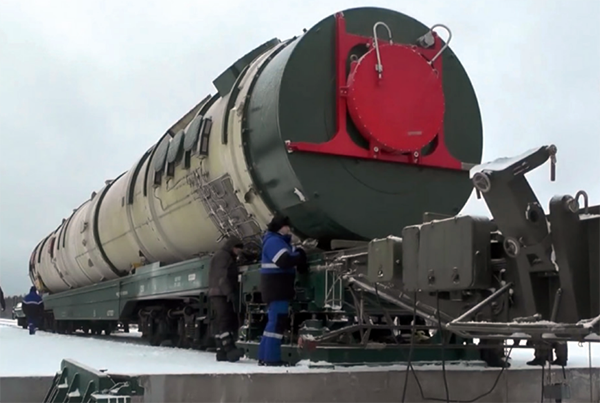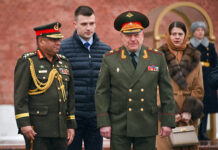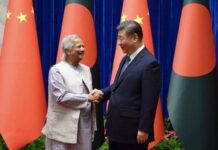The risk of nuclear war is greater today than at any other time since the Cuban missile crisis. In 1945, when the United States destroyed two Japanese cities with atomic bombs, it was the world’s sole nuclear power. Nine countries now possess nuclear weapons, others may soon obtain them, and the potential for things going terribly wrong has vastly increased.
Before the attack on Ukraine, the five nuclear-haves under the Non-Proliferation Treaty (NPT) — the United States, the United Kingdom, Russia, China, and France — had reached agreement that the use of nuclear weapons could be justified only as a purely defensive measure in response to a nuclear or large-scale conventional attack. In January 2022, those five countries issued a joint statement affirming that “a nuclear war must never be fought and can never be won.” A month later, Russia invaded a non-nuclear country, Ukraine, and threatened nuclear attacks against anyone who tried to help that country.
President Vladimir Putin and other Russian officials have been ominously threatening to use nuclear weapons in the war against Ukraine. The long-range ballistic missiles deployed on land and on submarines are Russia’s only nuclear weapons available for immediate use.
In 2021, during a training exercise involving about 200,000 troops, the Russian army practiced launching a nuclear assault on NATO forces in Poland. An intentional or inadvertent Russian attack on a NATO country could be the beginning of World War III.
If Russia decides to attack Ukraine with “tactical” nuclear weapons, the transportation to military bases, mating with cruise or ballistic missiles, loading on planes, etc will observed by the US in real time.
President Joe Biden has made clear that any use of nuclear weapons in Ukraine would be “completely unacceptable” and “entail severe consequences.”
Likely Scenarios
Russia might use a nuclear weapon by
• Detonation over the Black Sea, causing no casualties but demonstrating a resolve.
• A decapitation strike against the Ukrainian leadership.
• A nuclear assault on a Ukrainian military target.
• The destruction of a Ukrainian city, causing mass civilian casualties.
US Response
According to The New York Times, the Biden administration has formed a Tiger Team of national-security officials to run war games on what to do if Russia uses a nuclear weapon.
Biden administration’s strategy is of “deliberate ambiguity.” But everyone hopes that some form of back-channel diplomacy is secretly being conducted. The Russians have probably been given a message about how harshly the US might retaliate if they cross the nuclear threshold. But misunderstandings, miscommunications, and mistakes can lead to a nuclear catastrophe.
Some experts feel that if Russia uses a nuclear weapon in Ukraine, American nuclear retaliation should be the last resort. Instead, the US should opt for horizontal escalation, solely with conventional weapons. Russia’s Black Sea fleet might be sunk in retaliation, and a no-fly zone could be imposed over Ukraine, even if it meant destroying anti-aircraft units on Russian soil.
During the summer of 2016, the US national-security team secretly staged a wargame in which Russia invades a NATO country in the Baltics and then uses a low-yield tactical nuclear weapon against NATO forces to end the conflict on favorable terms. The security team reached widely divergent conclusions about what the United States should do. Some decided that the United States had no choice but to retaliate with nuclear weapons. Choosing a suitable nuclear target proved difficult, however. One committee recommended a nuclear attack on Belarus—a nation that had played no role whatsoever in the invasion of the NATO ally but because it was a Russian ally.
Others argued that retaliating with a nuclear weapon would be a huge mistake. It would be more effective to respond with a conventional attack, they recommended, and turn world opinion against Russia for violating the nuclear taboo.
Any nuclear attack on Ukraine would inspire global condemnation, especially from countries in Africa and South America, continents that are nuclear-weapon-free zones. China has long supported “negative nuclear assurances” and promised in 2016 “unconditionally not [to] use or threaten to use nuclear weapons against non-nuclear-weapon states or in nuclear-weapon-free zones.”
Others preferred “a muscular diplomatic response” to the nuclear strike, not a nuclear or conventional military response, combined with some form of hybrid warfare. The United States could launch a crippling cyberattack on the Russian command-and-control systems tied to the nuclear assault and leave open the possibility of subsequent military attacks.
Tactical Weapons
During the Cold War, the United States based thousands of low-yield tactical nuclear weapons in NATO countries and planned to use them on the battlefield in the event of a Soviet invasion. In September 1991, President George H. W. Bush unilaterally ordered all of America’s ground-based tactical weapons to be removed from service and destroyed. The United States was developing precision conventional weapons that could destroy any important target without breaking the nuclear taboo. But Russia never got rid of its tactical nuclear weapons.
The weakness of Russia’s conventional forces compared with those of the United States, Perry suggests, and Russia’s relative advantage in tactical weapons are factors that might lead Putin to launch a nuclear attack in Ukraine. Russia may be able to destroy a military target without much radioactive fallout, without civilian casualties, and without prompting a strong response from the United States. There would be an international uproar, but it would not last long.


















